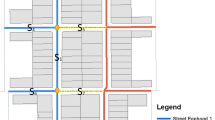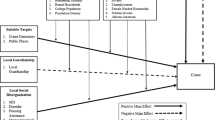Abstract
This paper provides a critical review of two broad categories of social ecological theories of crime, social integration and place-based theories, and their relationships to spatial assessments of crime patterns. Social integration theories emphasize the role of neighborhood disorganization on crime, while place-based theories stress the social interactions within and between places as a source of crime. We provide an analysis of the extent to which these two types of theorizing describe processes and mechanisms that are truly ecologic (identify specific interactions between individuals and their environments) and truly spatial (identify specific movement and interaction patterns of individuals and groups) as they endeavor to explain crime outcomes. We suggest that social integration theories do not provide spatial signatures of sufficient specificity to justify the application of spatial statistical techniques as quantitative arbiters of the theory. On the other hand, place based theories go some way toward addressing these issues because the emphasis is placed on understanding the exact physical and social characteristics of place and the activities that occur around locations as sources of crime. Routine activities and crime potential theories attempt to explain clustering or “hot spots” of crime in ways that give clear spatial dimension by looking at micro-spatial interactions between offenders and targets of crime. These theories have strong ecological implications as well, since they contain specific statements about how people use the space around them and how these patterns of use are related to patterns of criminal activity. We conclude by identifying a set of requirements for successful empirical tests of geospatial theories, including the development of valid measures of key theoretical constructs and the formulation of critical empirical assessments of geospatial hypotheses derived from motivating theory.


Similar content being viewed by others
References
Anselin, L., Cohen, J., Cook, D., Gorr, W., & Tita, G. (2000). Spatial analyses of crime. In D. Duffee (Ed.), Criminal justice 2000, Vol. 4. Measurement and analysis of crime and justice (pp. 213–262). Washington, DC: National Institute of Justice.
Banjeree, A., LaScala, E., Gruenewald, P. J., Freisthler, B., & Treno, A. (2008). Social disorganization, alcohol, and drug markets and violence: A space-time model of community structure. In Y. F. Thomas (Ed.), Geography and drug addiction (pp. 119–132). New York: Springer.
Block, R. L., & Block, C. R. (1995). Space, place and crime: Hot spot areas and hot places of liquor-related crime. In J. E. Eck & D. Weisburd (Eds.), Crime and place (pp. 145–183). Monsey, NY: Crimnal Justice Press.
Bottoms, A. E., & Wiles, P. (1997). Environmental criminology. In M. Maguire, R. Morgan, & R. Reiner (Eds.), The Oxford handbook of criminology (pp. 305–359). Oxford: Oxford University Press.
Brantingham, P. L., & Brantingham, P. J. (1993). Nodes, paths, and edges: considerations on the complexity of crime and the physical environment. Journal of Environmental Psychology, 13(1), 3–28.
Bursik, R. J. Jr. (1988). Social disorganization and theories of crime and delinquency: Problems and prospects. Criminology, 26(4), 519–551.
Clarke, R. V., & Felson, M. (1993). Routine activity and rational choice. New Brunswick, NJ: Transaction Publishers.
Cloward, R., & Ohlin, L. (1960). Delinquency and opportunity. NY: Free Press.
Cohen, L. E., & Felson, M. (1979). Social change and crime rate trends: A routine activity approach. American Sociological Review, 44(4), 588–608.
Felson, M. (1987). Routine activities and crime prevention in the developing metropolis. Criminology, 25(4), 911–931.
Freisthler, B. (2004). A spatial analysis of social disorganization, alcohol access and rates of child maltreatment in neighborhoods. Child and Youth Services Review, 26(12), 803–819.
Goldstein, A. P. (1994). The ecology of aggression. New York: Plenum Press.
Gorman, D. M., Speer, P. W., Gruenewald, P. G., & Labouvie, E. W. (2001). Spatial dynamics of alcohol availability, neighborhood structure and violent crime. Journal of Studies on Alcohol, 62(5), 628–636.
Gruenewald, P. G. (2007). The spatial ecology of alcohol problems: Niche theory and assertive drinking. Addiction, 102(6), 870–878.
Gruenewald, P. G. (2008). Why do alcohol outlets matter anyway? A look into the future. Addiction, 103(10), 1585–1587.
Gruenewald, P. J., Freisthler, B., Remer, L., LaScala, E. A., & Treno, A. (2006). Ecological models of alcohol outlets and violent assaults: Crime potentials and geospatial analysis. Addiction, 101(5), 666–677.
Gruenewald, P. J., Millar, A. B., Ponicki, W. R., & Brinkley, G. (2000). Physical and economic access to alcohol: The application of geostatistical methods to small area analysis in community settings. In R. Wilson & M. Dufour (Eds.), Small area analysis and the epidemiology of alcohol problems, NIAAA research monograph. Rockville, MD: NIAAA.
Gruenewald, P. J., Millar, A. B., Treno, A. J., Yang, Z., Ponicki, W. R., & Roeper, P. (1996). The geography of availability and driving after drinking. Addiction, 91(7), 967–983.
Kautt, P. M., & Roncek, D. W. (2007). Schools as criminal “hot spots”: Primary, secondary and beyond. Criminal Justice Review, 32(4), 339–357.
Kawachi, I., & Berkman, L. (2000). Social cohesion, social capital, and health. In I. Kawachi & L. Berkman (Eds.), Social epidemiology (pp. 174–190). New York: Oxford University Press.
Kubirin, C. E., & Weitzer, R. (2003). New directions in social disorganization theory. Journal of Research in Crime and Delinquency, 40(4), 374–401.
Lawson, A. B. (2008). Bayesian disease mapping: Hierarchical modeling in spatial epidemiology. Boca Raton, FL: CRC/Chapman & Hall.
Lipton, R., Gorman, D. M., Wieczorek, W. F., & Gruenewald, P. G. (2003). The application of spatial analysis to the public health understanding of alcohol and alcohol-related problems. In O. A. Khan (Ed.), Geographic information systems and health applications. Hershey, PA: Idea Group Publishing.
Livingston, M., Chikritxhs, T., & Room, R. (2007). Changing the density of alcohol outlets to reduce alcohol-related problems. Drug and Alcohol Review, 26(5), 557–566.
Lowenkamp, C. T., Cullen, F. T., & Pratt, T. C. (2003). Replicating Sampson and Groves’s test of social disorganization theory: Revisiting a criminological classic. Journal of Research in Crime and Delinquency, 40(4), 351–373.
Morenoff, J. D., Sampson, R. J., & Raudenbush, S. W. (2001). Neighborhood inequality, collective efficacy, and the spatial dynamics of urban violence. Criminology, 39(3), 517–559.
Parker, R. (1993). Alcohol and theories of homicide. In F. Adler & W. S. Laufer (Eds.), New directions in criminological theory: Advances in criminological theory (Vol. 4, pp. 113–141). New Brunswick, NJ: Transaction Publishers.
Portes, A. (1998). Social capital: Its origins and applications in modern sociology. Annual Review of Sociology, 24, 1–24.
Ratcliffe, J. H. (2006). A temporal constraint theory to explain opportunity-based spatial offending patterns. Journal of Research in Crime and Delinquency, 43(3), 261–291.
Roman, C. G., Reid, S. E., Bhati, A. S., & Tereschchenko, B. (2008). Alcohol outlets as attractors of violence and disorder: A closer look at neighborhood environment. Washington, DC: Urban Institute.
Roncek, D. W., & Maier, P. A. (1991). Bars, blocks, and crimes revisited: Linking the theory of routine activities to the empiricism of “hot spots”. Criminology, 29(4), 725–753.
Sampson, R. J. (1992). Family management and child development: Insights from social disorganization theory. In J. McCord (Ed.), Facts, frames, and forecasts (pp. 63–93). New Brunswick, NJ: Transaction Publishers.
Sampson, R. J. (1995). The community. In J. Q. Wilson & J. Petersilia (Eds.), Crime (pp. 193–216). San Francisco, CA: ICS Press.
Sampson, R. J. (2004). Neighborhood and community: Collective efficacy and community safety. New Economy, 11(2), 106–113.
Sampson, R. J. (2005). Social ecology and collective efficacy theory. In S. Henry & M. M. Lanier (Eds.), Essential criminology reader (pp. 132–140). Boulder, CO: Westview Press.
Sampson, R. J. (2006). Collective efficacy theory: Lessons learned and directions for future inquiry. In F. T. Cullen, J. P. Wright, & K. Blevens (Eds.), Taking stock: The status of criminological theory (pp. 149–167). New Brunswick, NJ: Transaction Press.
Sampson, R. J., & Groves, W. B. (1989). Community structure and crime: Testing social-disorganization theory. Criminology, 94(4), 774–802.
Sampson, R. J., Morenoff, J. D., & Gannon-Rowley, T. (2002). Assessing “neighborhood effects”: Social processes and new directions in research. Annual Review of Sociology, 28, 443–448.
Sampson, R. J., & Raudenbush, R. (1999). Systematic social observation of public spaces: A new look at disorder in urban neighborhoods. American Journal of Sociology, 105(3), 603–651.
Sampson, R. J., Raudenbush, S. W., & Earls, F. (1997). Neighborhoods and violent crime: A multilevel study of collective efficacy. Science, 277(5339), 918–924.
Scribner, R., Theall, K. P., Ghosh-Dastidar, B., Mason, K., Cohen, D., & Simonsen, N. (2007). Determinants of social capital indicators at the neighborhood level: A longitudinal analysis of loss of off-sale alcohol outlets and voting. Journal of Studies on Alcohol, 68(6), 934–943.
Shaw, C. R., & McKay, H. D. (1942). Juvenile delinquency and urban areas. Chicago: University of Chicago Press.
Sherman, L. W., Gartin, P. R., & Buerger, M. R. (1989). Hot spots of predatory crime: Routine activities and the criminology of place. Criminology, 27(1), 27–55.
Stark, R. (1987). Deviant places: A theory of the ecology of crime. Criminology, 25(4), 893–909.
Stockwell, T., Gruenewald, P. J., Toumbourou, J., & Loxley, W. (2005). Preventing harmful substance use: The evidence base for policy and practice. New York: Wiley.
Taylor, R. B. (2002). Fear of crime, local social ties, and collective efficacy: Maybe masquerading measurement, maybe deja vu all over again. Justice Quarterly, 19(4), 773–792.
Theall, K. P., Scribner, R., Cohen, D., Bluthenthal, R. N., Schonlau, M., & Farley, T. A. (2009a). Social capital and neighborhood alcohol environment. Health and Place, 15(1), 323–332.
Theall, K. P., Scribner, R., Ghosh-Dastidar, B., Cohen, D., Mason, K., & Simonsen, N. (2009b). Neighborhood alcohol availability and gonorrhea rates: Impact of social capital. Geospatial Health, 3(2), 241–255.
Tita, G., & Griffith, E. (2005). Travelling to violence: The case for a mobility-based spatial topology of homicide. Journal of Research in Crime and Delinquency, 42(3), 275–308.
Waller, L. A., & Gotway, C. A. (2004). Applied spatial statistics for public health data. New York: Wiley.
Weisburd, D., & Mazerolle, L. G. (2000). Crime and disorder in drug hot spots: Implications for theory and practice in policing. Police Quarterly, 3(3), 331–349.
Author information
Authors and Affiliations
Corresponding author
Rights and permissions
About this article
Cite this article
Gorman, D.M., Gruenewald, P.J. & Waller, L.A. Linking places to problems: geospatial theories of neighborhoods, alcohol and crime. GeoJournal 78, 417–428 (2013). https://doi.org/10.1007/s10708-011-9425-7
Published:
Issue Date:
DOI: https://doi.org/10.1007/s10708-011-9425-7




